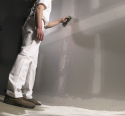
Dust is a common byproduct of drywall sanding, a key task in nearly every commercial and residential construction project. Dust and drywall sanding go hand in hand, just like hammer and nails, soap and water, or paper and gypsum. In fact, drywall sanding is one of building’s messiest jobs.
To say airborne drywall dust is a nuisance is an understatement. The cloud of dust clogs dust masks, blinds goggles, invades ventilation systems, and settles on everything-the carpet, baseboards, even electrical outlets. And since installers are continuously walking through dust, it can be easily tracked throughout a job site.
Drywall dust is especially a problem in projects where cleanliness and indoor air quality are critical such as in hospitals, schools, nursing homes, commercial offices and residential spaces. It's also a concern for those working at job sites that are still operating during construction, such as a bank or retail store, where employees interact with customers just feet away from temporary construction barriers.
Fortunately, unlike drywall knives, screws and tape, drywall dust doesn’t have to be a standard at the job site. By using a low-dust joint compound, contractors can save both time and money on cleanup, while increasing client satisfaction at the same time.
Unique low-dust joint compounds have all the benefits of traditional compounds, however they are specifically created to decrease airborne dust. A special quality in low-dust compounds binds dust particles together to create a “heavy dust” that, when sanded, falls straight to the floor. It produces the same quality finish as other all-purpose compounds, but without the cloud of dust-making prep time and cleanup faster and easier.
“The mess associated with drywall has long been a concern to contractors and owners alike,” says Myron Ferguson, a nationally recognized drywall authority and president of Ferguson Drywall Innovations in Albany, N.Y. “The low-dust joint compound addresses these concerns and effectively minimizes dust, making cleanup easier and more efficient.”

Cleanup is a necessary part of any construction project. Patrick Hillman, owner of Bosse Drywall Inc. in Cincinnati, estimates 3 to 5 percent of his crews’ time is dedicated to cleanup. The drywall dust that invades every square inch of the jobsite takes hours, even days, to clean up. Not only is it time consuming, it’s expensive too as many contractors outsource the cleaning to professionals.
By reducing dust with a low-dust joint compound, many contractors and drywall installers have saved hours of cleanup and prep time, getting the job done faster, and leaving behind a good, clean finish and a clean workspace.
In fact, on the job testing showed a considerable difference between Sheetrock Brand Dust Control from USG and a regular joint compound. Even 15 minutes after sanding stopped, airborne dust from the regular joint compound was substantially higher than that from the dust control product.
Mike Michaels, of Leopardo Construction in Chicago, has used the product since it first became available three years ago. He found that with less mess, his firm saved money. “In the past, we had to get a cleaning service to wipe everything down. Now we can easily clean it up as we go. Usually when we sand, the dust falls right along the wall. We can vacuum and clean up in hours instead of days.”
In addition to the dust-control benefit, the material’s low shrinkage, excellent adhesion and resistance to cracks help users save even more time and money because they can apply just two coats of compound when covering metal surfaces such as corner beads and fasteners. The material also weighs up to 30 percent less than conventional compounds, which makes handling, application and sanding quick and simple.
A Safer Alternative
Unlike traditional joint compounds, low-dust compounds are specially engineered to reduce the amount of airborne sanding dust. The National Institute of Occupational Health and Safety recognizes that extended, unprotected exposure to drywall sanding dust can cause eye, nose, throat and respiratory tract irritation. Since low-dust joint compounds minimize the amount of airborne dust, it reduces dust exposure to help create a healthier working environment for installers and others on the job site.
Furthermore, there are low-dust products available that have very low volatile organic compound content and meet or exceed all EPA and OSHA requirements.

Contractors note that increased client satisfaction is a benefit when using a low-dust joint compound. This is especially beneficial as many contractors rely heavily on referrals to generate business. Unhappy customers who find drywall dust long after the crew is gone can lead to negative reviews.
Ray Anderson of R.A.C.E. Drywall in Wheaton, Ill., says when he points out to clients that he used low-dust joint compound, they really appreciate it. “When we sand in the living room, they don’t have to worry about dust on the bedroom nightstand upstairs. Even with a vacuum cleaner sander attachment, dust can be a factor. But with this product, we’re able to clean up 100 percent of the dust.”
Alan Hendy, owner of Neal’s Design in Cincinnati, echoes that sentiment. “Drywall sanding is one of the stages of remodeling that my clients worry about the most. They know it’s the dirtiest part of the project,” he says.
In today’s economy, contractors are always looking for ways to save money, boost productivity and differentiate themselves from the competitors. All, while producing quality work and leaving customers satisfied. Using products like low-dust joint compound minimizes time and costs for contractors and practically guarantees a cleaner job site.
The results are a safer work environment, a happier client, and perhaps most importantly-more money in your pocket.


